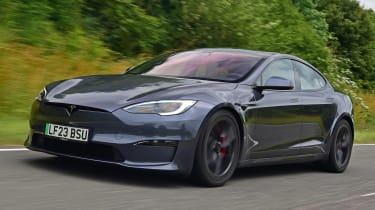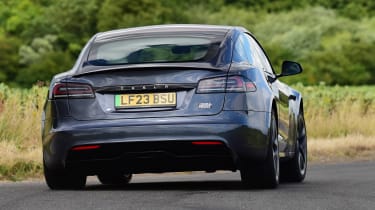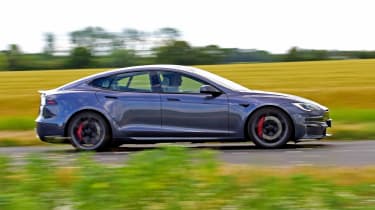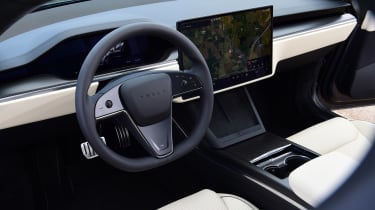Tesla Model S Plaid 2023 review
A comprehensive facelift has brought Tesla’s pioneering EV up to date, and we’ve driven it in 1020bhp Plaid spec
How would you spend your first few miles in a Tesla Model S Plaid, a car that accelerates from 0-60mph in less than 2sec, one that can outrun almost any supercar you care to mention? It all feels quite eerie to begin with. Trundle around at low speed and the Plaid feels like a completely ordinary electric car, and the experience isn’t exotic in the slightest. But this all heightens the sense of anticipation – you’re aware that this whisper-quiet, clean-cut saloon is hiding enormous potential, and unfathomable speed is just a toe-twitch away. But what that performance means in the real world – and whether there’s any depth beyond it – is what really matters, and what we aim to find out.
The Plaid arrives as part of a thorough update to the Model S, which is now only available in left-hand drive in the UK. That will immediately turn off some potential buyers, but the Plaid’s unique status as the world’s fastest accelerating saloon naturally cuts it some slack compared with the standard car; you don’t choose the Plaid for sensible, rational reasons, but for the absurd numbers it can generate. And absurd they certainly are.
More reviews
Reviews
The headline figures are 1020bhp, 0-60mph in 1.99sec (including a one-foot rollout), a quarter-mile sprint of 9.23sec and a top speed of 200mph. It’s all made possible by a triple electric motor layout (one 421bhp unit at the front and a 414bhp motor at each rear wheel) and new carbon-sleeved internal rotors. Compared to normal steel sleeves, carbon is better at preventing rotor expansion from centrifugal force at high revs, which is partly why the Plaid can achieve such a high top speed for an EV.
The Model S platform has been around since 2012, but if Tesla is to be believed, it remains one of the lightest cars in its class; the Plaid comes in at 2167kg, undercutting the Porsche Taycan Turbo S by 128kg. But while the core structure is familiar, Tesla’s heavily digitised approach to interior design has been developed further in the latest Model S. The original car’s enormous portrait touchscreen has been replaced by an equally massive landscape-orientated panel, which controls pretty much every cabin function; including gear selection, glovebox opening and access to mirror and steering wheel adjustments.
Ah yes, the steering wheel. Our car was fitted with a conventional round wheel rather than the yoke, but there are still some questionable ergonomic choices – namely the indicators, which are operated by small haptic buttons on the left-hand spoke. They’re fine on the motorway, cleverly detecting when a lane change has been made to self-cancel, but in those critical moments when your hands are busy (on a roundabout for example), they’re easy to miss and plain frustrating. The fit and finish, while perfectly acceptable and an improvement over the old Model S, isn't a patch on BMW's finest either.
It’s a shame, because the Model S’s interior does other things so well. The infotainment feature set is outstanding, this new model coming loaded with an onboard gaming system, crisp, high-definition media streaming and one or two gimmicky – but admittedly quite fun – ‘Toybox’ features, like a drawing pad and an external speaker that projects fart sounds to the outside world. Childish, yes, but the sense of humour is refreshing.
Once you’ve finished with the toys, swipe up on the side of the touchscreen to engage drive and pull away. With the powertrain in its most subdued Chill mode the Plaid feels about as quick as a Cupra Born, and the throttle calibration is seamless and intuitive; the expertly judged regen allows you to drive using one pedal, coming to a neat stop without touching the brakes. But the Model S has always been a big car and the switch to left-hand drive accentuates this further – it needs some thought to position accurately on the road, and that’s apparent from the get-go.
You also need to think long and hard about when – and where – you choose to finally tap into that colossal performance. Find a clear, straight road, switch to Plaid mode and the Model S Plaid delivers just about the most brutal, stomach-churning whack of forward thrust you can experience in a road car. The world rushes past as one mush of colour and you simply hang on, watching the speed climb by chunks at a time. It’s truly remarkable. But enjoyable? To an extent, yes. Feeling such relentless force on your body is strangely addictive. But once you get past the shock factor (which admittedly takes more than a few launches), you start searching for more layers beyond the straight line performance.
For the most part, the Model S Plaid doesn’t quite deliver them; and certainly not to the level of a Taycan. By normal standards the Model S is competent, refined and secure, but it feels a generation old in some areas, and you could argue that the Plaid’s £113,480 asking price warrants more than that.
On a testing road, squirting between corners in Plaid mode is unnerving rather than fun, and we found ourselves notching back to the more manageable (but still rapid) Sport mode. Of the suspension settings, Comfort amplifies the impression of mass with the vertical float it induces, with Sport dialling this out for more direct, occasionally abrupt damping. It’s an acceptable compromise, but the Model S doesn’t have the serene, absorbent feel of a BMW i7, nor the flat, precise cornering attitude of a Taycan. The sense of inertia is more present, more of the time (particularly on the brakes, which don’t inspire confidence with their soft initial response).
The outright speed the Model S can carry is mighty impressive though, and easy to access; the Michelin Pilot Sport 4S tyres dig in and deploy all that power with nothing but a slight tug through the wheel. Delve deeper into the drive mode menu and the Plaid offers one final trick: Track mode. Allowing freedom over the level of stability control, regen and the torque split between the axles, Track mode locks the powertrain in Plaid mode and primes the powertrain cooling system to deliver consistent performance. Setting a 25/75 front-to-rear torque split brings a more expressive, rear-led balance that certainly focuses the mind with the ESC off.
That said, the underlying poise and fine-graded feel of a true sports saloon is still missing, and so is the imperious, sumptuous feel of a cutting edge luxury EV. There’s certainly a lot to like here, from the class-leading tech suite, Tesla’s seamless charging infrastructure and excellent efficiency (we achieved 320 miles from a full charge), but with the rise of new, more complete EVs, the Model S no longer leads the pack – and there’s nothing 1020bhp can do to change that.




